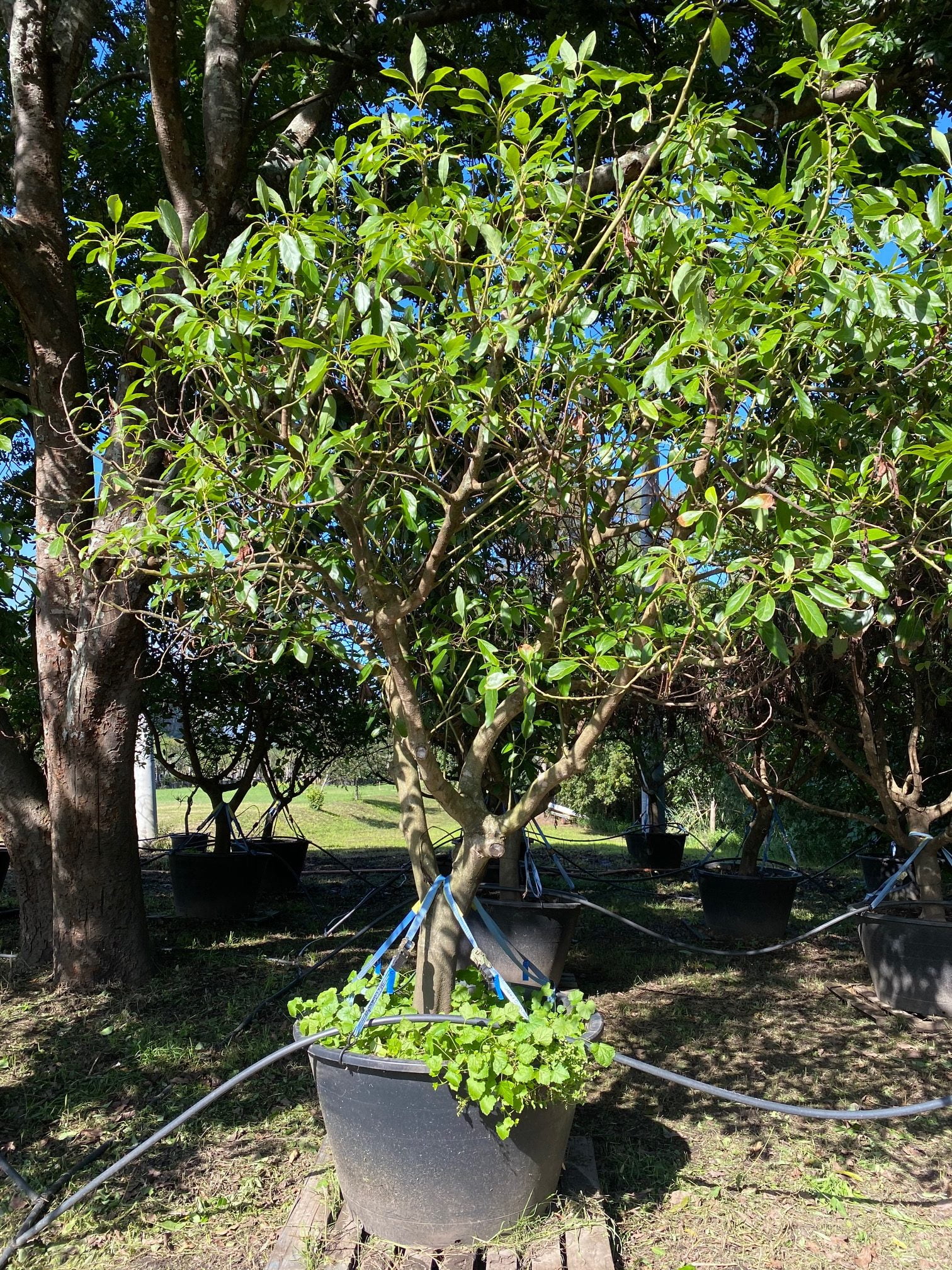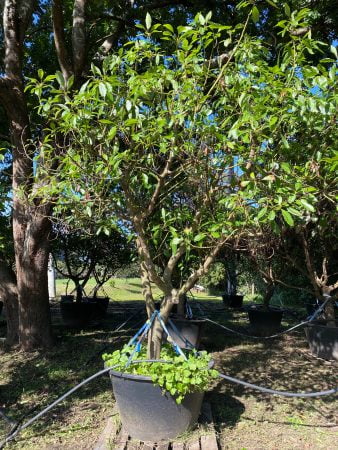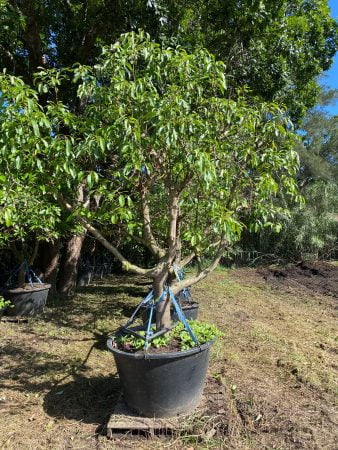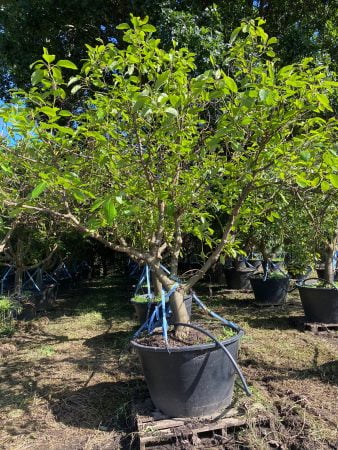Avocado Tree
The Avocado Tree (Persea Americana) is one of the world’s most common fruit trees and makes a perfect specimen for gardens in tropical and subtropical areas. It does require a frost-free environment but there are slightly more cold-tolerant varieties available, allowing it to be grown as far south as Melbourne.
Origin: The Avocado Tree originated in southern Mexico where the warm climate makes it a perfect region for growing avocado pears. That said, parts of South America, Africa, and California are prolific exporters of avocados today. There are three varieties with varying cold tolerances, namely the West Indian, Guatemalan, and Mexican Avocado Trees that can sustain temperatures just below freezing. However, the longer the freeze, the more potential there is for damage.
Growing: Growing the Avocado Tree in climates with a minimum of 15 degrees Celsius is optimal. Easy to grow and highly rewarding, it looks stunning when the whole tree is in bloom; dripping with panicles of greenish-white star-shaped flowers. It also has the added bonus of providing you with a high yield of the ‘super-food’ Avocado fruit.
Environment: This popular evergreen tree is well suited to domestic gardens. It develops a lovely dense, natural growth habit but is also easy to prune to maintain a smaller size if required. The Avocado Tree is suitable for container growing meaning it can be grown as a patio plant and easily transferred indoors for winter protection. It also makes a really lush house or office plant.
Our Avocado Trees
Here at Designer Trees, we have Avocado Trees in a wide range of sizes and varieties, including some slightly more cold tolerant Avocado Trees such as ‘Bacon’. Commercially grown Avocados are often grown by grafting and various types of rootstock are becoming more widely available. This means you can select a rootstock (e.g. a dwarf rootstock for container or small garden planting) that is well-suited to your chosen planting area.
- Avocado Tree 03
- Avocado Tree
- Avocado Tree 01
We are always on hand and happy to help you to select the perfect specimen for your home.

Frequently Asked Questions
What is the most common problem when growing Avocado Trees?
Container grown plants must be raised slightly from the ground so that the water can drain freely from the holes at the base of the pot. The most common cause of problems when growing the Avocado Tree is soil saturation – it absolutely hates to have its roots sat in water as this leads to rotting.
Continue reading about Avocado Tree care.
How long does it take for avocado trees to bear fruit?
If you buy a young tree and plant it, you can expect to see the bearing of fruit between three to five years. However, if you plant an Avo Tree from seed, it will only bear fruit from five or even thirteen years after planting.
Continue reading about Avocado Tree care.
Are Avocado Trees high maintenance?
Such an easy to grow tree, the Avocado requires very little ongoing care and maintenance. It needs no pruning to maintain health and is self-pollinating. Fruit can be left on the tree for several months as it doesn’t ripen until picked. In the wild, this usually takes 1-2 weeks after falling naturally.
Continue reading about Avocado Tree care.
How can I grow an Avocado Tree?
Commercially, Avocado Trees are propagated by grafting and layering. The industry has, over recent years, been developing in the area of grafting and rootstock production leading to a wider range of Avocado Trees being available for different planting and growing requirements.
Avocado trees are really fun and easy to grow from seed too!
Continue reading about Avocado Tree care.
Where can I buy an avocado tree?
We are one of the leading suppliers of Avocado Trees in Australia. We are fully licensed by the NSW Office of Environment and Heritage to sustainably harvest several species and we are proud to say that we have one of the largest ranges of Avocado Trees.
Click here to get a quote.
Avocado Trees: Appearance
The Avocado Tree (Persea Americana) is an evergreen tree with a lovely natural habit and dense green foliage. Small greenish-white star-shaped flowers are followed by pear-shaped, dark green fruits with edible flesh. A vigorous but relatively short-lived tree, it can grow to heights of 10m or more over 10-20 years.
Lance-shaped or elliptic, evergreen leaves are alternately arranged along the branch and measure approximately 10-30cm long and 4-10cm wide.
Terminal buds are covered in lots of pale, silky hairs.
Greenish-white star-like flowers appear from leaf axils on new growth, from Winter to early Spring. At only 5-10mm the flowers are insignificant individually but, as they grow in panicles of up to 600 individual flowers when the whole tree is flowering at its peak it makes a stunning sight.
The Avocado fruit is a green, usually rough-skinned, single-seeded berry. It has a pear-shaped, fleshy body that measures between 7-20cm long and approximately 7cm in diameter. The large seed can measure between 4-6.5cm. The fruit is climacteric, growing to maturity on the tree and then falling to the ground where it ripens, usually 7-10 days later.
The Avocado is usually self-pollinating but it is worth noting that the tree has two different types of flowers – Type A and Type B.
- Type A flowers open as females and are receptive to pollen during the morning of the first day. The following afternoon they open as males and release pollen.
- Type B flowers open as females and are receptive to pollen during the afternoon of the first day. They reopen as males and release pollen the following morning.
When purchasing an Avocado Tree you may come across ‘A cultivars’ & ‘B cultivars’ and this is referring to the type of flowers, as described above, that the cultivar has.

Avocado Trees: Planting
If you buy a young tree and plant it, you can expect to see the bearing of fruit between three to five years. However, if you plant an Avo Tree from seed, it will only bear fruit for five or even thirteen years after planting. In spring, summer, and autumn, the avo plant should get at least 15 millimetres of water, twice a week, if there is no rain. If the plant dries out between watering sessions, particularly during very hot temperatures, it will need extra watering to prevent the root system from surfacing.
The tree will grow well from a deep, slow watering system and a drip system is ideal in this case as it helps the water penetration to reach the roots. During winter, creating a berm around the plant will prevent water from accumulating as the Avo Tree is averse to the soil, which gets too cold or damp. Avocado Trees love well-drained soils and fertilisers are not necessary to ensure the health or growth of the tree as their feeder roots are very sensitive.
As a tropical/subtropical plant, the Avocado Tree needs to be planted in a sunny position with protection from frost. The more sun it gets the more fruit it produces. In areas susceptible to winter temperatures lower than 5-10C the tree is best planted into a pot so that it can be moved indoors during the colder months.
A young Avocado Tree will prefer shade to protect its sensitive bark because, in its natural habit, the small avo plant will start its life by growing beneath the mother tree’s branches that provide the much-needed sun protection. As the tree grows bigger, it will thrive in full sunshine and get the shelter it needs from its ample foliage. If you need to plant a young tree in a sunny position, build a structure to provide shade until it’s ready to withstand the direct sun.
Avocado trees also need to be sheltered from the wind. They like a high humidity level to prevent the flowers from becoming dehydrated. Exposure to drying winds reduces humidity levels causing pollination problems and therefore less prolific fruiting. The branches can also be quite brittle and are prone to breaking in high winds.
Bear in mind that The Avocado is a rainforest tree when it comes to growing conditions and you won’t go far wrong. As you would expect, it develops a lush, leafy canopy that creates a lot of shade and it does drop quite a lot of leaves. These conditions should be considered if you are planning to plant your tree amongst an existing planting scheme as light levels on the ground will reduce as the tree matures.
It has a shallow root system that can quickly dry out so is best planted in humus-rich, moist but well-drained soil with a neutral pH. It doesn’t do well in alkaline soil and will often develop chlorosis (yellowing of the leaves) if grown in this soil type. Sharp sand or gravel should be incorporated into the planting hole or potting mix and the application of a thick mulch after planting will prevent water loss. Do not mulch too close to the trunk as this can cause rotting.
Container-grown plants must be raised slightly from the ground so that the water can drain freely from the holes at the base of the pot. The most common cause of problems when growing the Avocado Tree is soil saturation – it absolutely hates to have its roots sit in water as this leads to rotting.
Avocado Trees: Ongoing Care and maintenance
Such an easy-to-grow tree, the Avocado requires very little ongoing care and maintenance. It needs no pruning to maintain health and is self-pollinating. Fruit can be left on the tree for several months as it doesn’t ripen until picked. In the wild, this usually takes 1-2 weeks after falling naturally.
All that is needed is protection from frosts in cold-prone areas and regular, deep watering to prevent the soil from drying out.
Avocado Trees can be prone to pests and diseases so it is advisable to monitor regularly for signs of any potential problems. Some of the most common ones to look out for are whitefly and spider mites if grown in a glasshouse, thrips, mealybug, fungal leafspots, root rot and Phytophthora.
Biennial-bearing, where fruiting is prolific one year and sparse the next, is common in some Avocado Tree cultivars so a reduced yield is usually not an indication of problems with your tree. It is also worth noting that in some years, environmental conditions can cause the appearance of seedless fruit which again is nothing to worry about.
The flowering behaviour of this tree is unique and complex. A mature tree produces over a million flowers in its flowering season and will typically fall off without producing fruit. This encourages pollen vectors like the European honeybee to visit and stimulate the pollination process. Although the Avocado Tree is capable of self-pollination, growing trees in pairs will promote cross-pollination for increased fruit production.
Fruiting is most prolific in areas where, during the flowering period, nighttime temperatures stay above 10C and daytime temperatures below 25C until the fruit has set.
If your Avo Tree is potted indoors, it will require some pruning to limit its height or spread, but this should only be done before its flowering stage. However, there will come a time when the tree will require transplanting into the ground outside as they can grow up to 12 metres high and 4-6 metres wide. When moving the Avocado Tree from a pot to an outdoor location, take special care to keep its fragile root ball intact.
Avocado Trees: Propagation
Commercially, Avocado Trees are propagated by grafting and layering. The industry has, over recent years, been developing in the area of grafting and rootstock production leading to a wider range of Avocado Trees being available for different planting and growing requirements.
Avocado trees are really fun and easy to grow from seed. Seed-grown plants won’t produce fruit for at least 4-6 years, sometimes longer, but they are great to grow as container specimens that you can dot around the house and garden to quickly provide an abundance of lush, tropical foliage in your home.
To grow an Avocado Tree from seed, push three toothpicks into the sides of the seed at a slightly upward-sloping angle. Suspend the seed, pointed end upwards, above the opening of a clean jar of water. Maintain a water level that covers approximately half the seed and place it in a bright spot, but away from direct sunlight. Your seed should sprout in around 4-8 weeks, depending on how warm the environment is.
Once the shoot has emerged, remove the seed from the jar and plant it into a general-purpose compost with added sharp sand to aid drainage. Take care not to damage any roots or shoots when transplanting the seed.
Water regularly to ensure that the soil never dries out but always remember, this plant should not have its roots sat in waterlogged soil!
Avocado Trees: Toxicity
The Avocado Tree is considered highly toxic to almost all animals.
The seeds and leaves are poisonous to humans and occasionally consumption of the fruit can lead to an allergic reaction.
There are two main types of allergies:-
- Hayfever-type reactions of swollen and irritated airways.
- Latex-fruit Syndrome reactions of urticaria, abdominal pain and vomiting.
Avocado Trees: History
The Avocado Tree is a variable species and therefore it is quite difficult to pinpoint its exact origin. It is thought to originate from Central Mexico but archeological evidence suggests that similar species were much more widespread. There is evidence of three separate domestications of the Avocado – Mexican, Guatemalan and West Indian races. Each race has its own unique characteristics.
A long history of cultivation in Central and South America has been documented, possibly going back to 5000 BC. An avocado pit found in a cave in the Tehuacan Valley of Mexico has been dated to be around 9-10,000 years old!
It is thought that the native, undomesticated variety known as ‘Criollo’ co-evolved with now-extinct megafauna (giant animals-dinosaurs!) who would have eaten the small black fruits and distributed the seeds far and wide through their droppings.
Being such a high-value tree, the Avocado began to be introduced to the rest of the world at the start of the 1600s and was brought to Australia in the late 19th century.
Avocado Trees: Distribution and Habitat
The Avocado Tree is thought to originate in South and Central Mexico, and Central America. It is found growing in the highlands of Mexico & Guatemala, and the lowlands of the West Indies, most commonly growing in rainforest areas at altitudes of 700-1500m.
Local adapted, traditional varieties have developed over time bringing diversity to the species and it is now cultivated commercially in Mexico, Peru, California, New Zealand and South Africa. Introduced to Australia in the late 19th century, it has become naturalised in North Eastern Queensland.
While growing an Avocado Tree outside its natural climate range may present some challenges, it is still achievable and will bring great pleasure in the years to come as this tree bears one of the most nutrient-packed fruits, the avocado pear. If living in colder regions, the Mexican or Guatemalan plants can be started off in a pot indoors and as it matures, the tree can be moved outside. The West Indian variety can be directly planted outdoors if you live in a warm and sunny climate.
Avocado Trees: Taxonomy and Naming
Family: Lauraceae
Genus: Persea (From Latin and Greek ‘Persea’ meaning a fruit-bearing, tropical ornamental tree or shrub)
Species: Americana (meaning typical of the USA)
Synonyms: Laurus Persea, Persea Gratissima and many more. See http://www.theplantlist.org/tpl1.1/record/kew-2529835 for the full list
Common names: Avocado, Alligator Pear, Avocado Pear, Butter Fruit
The word ‘avocado’ comes from the Spanish ‘aguacate’ which in turn comes from the Aztec word ‘Ahuacatl’ meaning ‘Testicle Tree’.
Avocado Trees: Uses
Due to the popularity of avocado as a modern health food the Avocado Tree is commercially valuable and widely cultivated in tropical and Mediterranean climates around the world.
It has a wide variety of culinary uses and is a great source of ‘good’ mono-unsaturated fats and protein. It is also very high in essential vitamins and minerals. The leaves of Persea Americana var Drymifolia are sometimes used as a spice. It has an anise-like flavour and is commonly added to bean dishes.
The Aztecs considered the avocado to be a fruit of fertility and the Mayans used it as an aphrodisiac.
The avocado pit, when crushed, releases a milky liquid that turns red or black when exposed to the air. It has been used as ink for writing and also as a natural dye.
The oil is very nourishing to the skin and hair and is widely used as a natural ingredient in hair and beauty products.
Request A Quote Now.
Call Us For An Instant Quote!
Australia:
0461 486 193
International:
+61 461 486 193
Email – hello@designertrees.com.au


